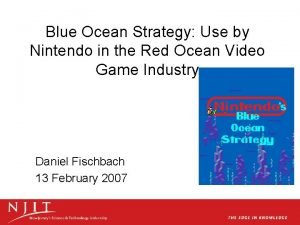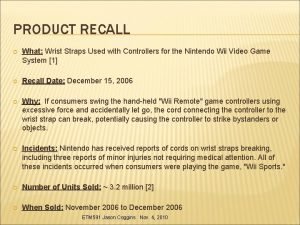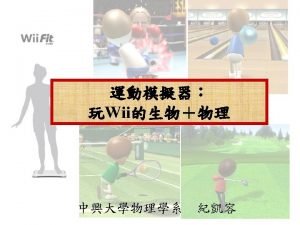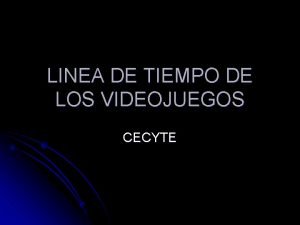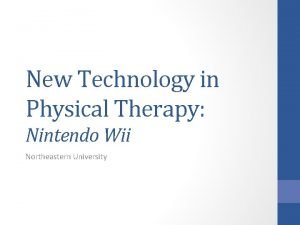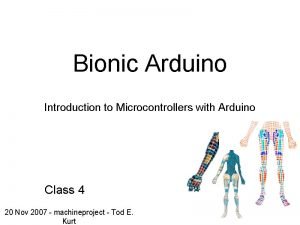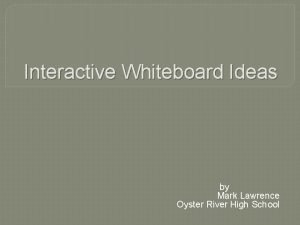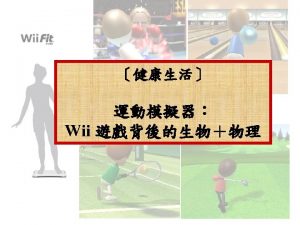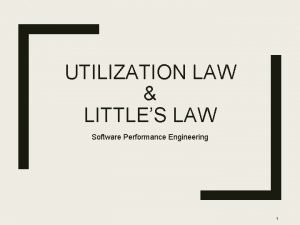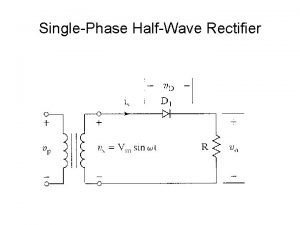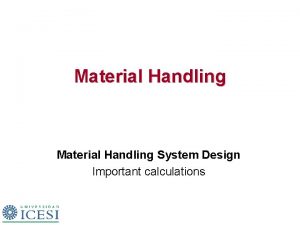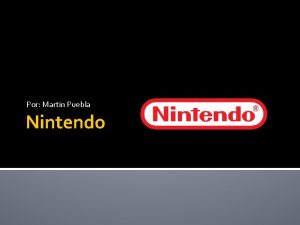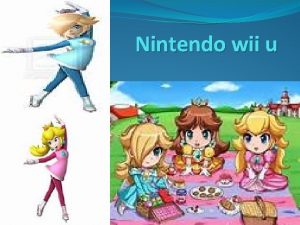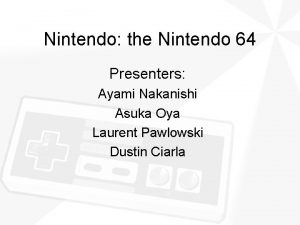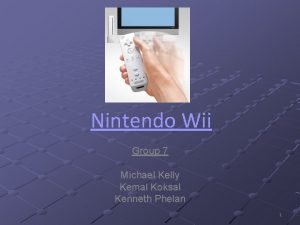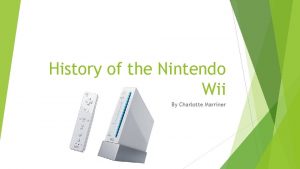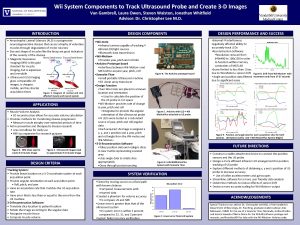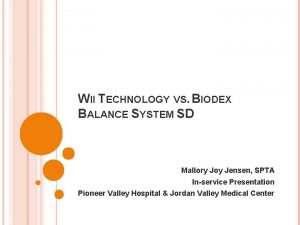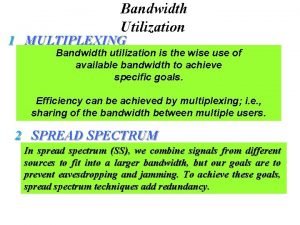UTILIZATION OF THE NINTENDO WII IN SCHOOL SYSTEM





























- Slides: 29

UTILIZATION OF THE NINTENDO WII IN SCHOOL SYSTEM PHYSICAL THERAPY Allison Rowe, SPT Presented Wednesday, April 17 th 2013

Potential of the Nintendo Wii. TM as a rehabilitation tool for children with cerebral palsy in a developing country: a pilot study

Inclusion Criteria 2 • Children between the ages of 6 and 12 years • Adequate cognition to understand the interaction required for use of the gaming system • Visible shoulder and elbow movement

Participants

Intervention 2 • Each participant assessed using the Gross Motor Function Measure (GMFM) prior to the start of the intervention. • 2 days/week on set days for 6 -weeks • 45 minutes in an open room with others being treated in the same area. • Wheelchair-dependent participants trained on a stool in unsupported sitting, ambulant participants were trained while standing.

Intervention 2 • For participants who did not have a grasp strong enough to hold the Wii remote in their hand for the duration of the study, a crepe bandage was used to secure it. • Training was initiated with Wii Sports Boxing. • Progression was made to Wii Baseball and then finally Wii Tennis. • Participants were then re-assessed using the GMFM by one of the same two evaluators from the pre-assessment.

Results 2

Results • GMFM has been validated for CP 3 • The use of the GMFM determined whether or not there was a change in a child’s motor function, rather than the quality of a skill that was learned from the virtual reality therapy 3 • Has been proven to be reliable in all dimensions of the measure • The use of virtual reality did impact overall gross motor function following the 6 -week training program 2

Use of a Low-Cost, Commercially Available Gaming Console (Wii) for Rehabilitation of an Adolescent With Cerebral Palsy

Case Description 1 • 13 year old adolescent attending a summer program at school for children with developmental disabilities. • Spastic diplegic CP and delayed development • Poor motor planning, poor ability to sustain attention and poor ability to complete tasks.

Case Description 1 • 3 months prior to intervention: • Active motion in all extremities, with better isolated movement of UEs vs LEs. • L UE dominant functional arm. • Posture in supported standing semicrouched with hip internal rotation and ADD. • Sitting posture included posteriorly tilted pelvis, laterally flexed trunk with convexity to R and flexed posturing of R UE. • Decreased ROM in hip EXT, ER, knee FLX and ankle PF • Poor abdominal strength, lacked core stability • Ambulating independently with B AFOs and a posterior rolling walker

Case Description 1 • Projected PT goals for upcoming school year: • Independent standing for 5 minutes using one forearm crutch while performing an activity • Ambulating 200 ft using forearm crutches with CGA without LOB • Upright midline sitting on a bench or bolster for up to 10 minutes, requiring fewer than 2 verbal cues.

Outcome Measures 1 • Quality of Upper Extremity Skills Test (QUEST) • GMFM • Subtests D (standing) and E (walking, running, and jumping) • Visual-perceptual processing: • The Test of Visual Perceptual Skills, third edition (TVPS-3) • Postural control: • Measures of weight distribution and sway collected during static stance with eyes open and with eyes closed on a Posture Scale Analyzer • Functional mobility: • Retrospective data from chart review for walking distance

Intervention 1 • Wii Sports selected based on patient interest and applicability to goals • Games played in training or game mode in both sitting and standing • 11 sessions over 4 weeks, ranging from 60 to 90 minutes • Treatment administered during summer session in addition to his regular therapies.

Results: Visual-perceptual Processing 1

Results: Postural Control 1

Results: Functional Mobility 1

Discussion Points • Feasibility • Television access • Financial cost • Cognition and motivation • Low IQ rating, reported attention deficits • Multi-player function • Long term use

Explanations for improvement 1: • Intensity of treatment • Duration, repetitions • Training was task driven and required problem solving* • Known to promote behavioral changes and neural plasticity in children with CP • Multisensory feedback provided by the system translates to learning and performance improvements • Auditory, visual and haptic information along with provision of KP and KR

Wii Games

Wii Sports 1 • Golfing: • Requires judgment of force, distance, and figure-ground discrimination, with high accuracy constraints. • Boxing: • Requires midline trunk orientation and endurance of trunk muscles. • Requires bilateral upper extremity reciprocal movements that promote midline trunk alignment

Wii Sports 1 • Bowling: • Requires trunk stabilization while moving a single upper extremity with varying degrees of force. • Standing games: • Emphasize balance with weight transfer between the lower extremities • All games: • Upper-extremity control • Trunk control • Timing • Hand-eye coordination

Wii Fit • Balance training • Visual feedback • Body awareness • Balance board can be used with many assistive devices • Weight shifting • Balance Reactions • Potential to work on head control

Dance Revolution • Strength and endurance • Following sequences • Vestibular/movement input • Allows therapist to adjust speed and level of activity • Timing of movements • Placement of lower extremities

Guitar Hero • Hand eye coordination • Reaction timing • Concentration and coordination • Hand function and movement

Adaptation Ideas • UE Strengthening • ‘Dumbbells’ come in 2 or 5 pounds!

Benefits of Wii utilization • Working with peers: Turn taking, strategy sharing, encouragement, improved form • Excitement of using a ‘video game’ during therapy • Feedback, competition, self efficacy 4 • Visual Reality System Potential Benefits 1: • Improve reaching behaviors • Produce cortical reorganization • Improved visual-perceptual processing • Requires hand use and finger dexterity to continue 4 • Potential therapeutic reward

Questions?

References 1. Deutsch JE, Borbely M, Filler J, Huhn K, Guarrera-Bowlby P. Use of a low-cost, commercially available gaming console (Wii) for rehabilitation of an adolescent with cerebral palsy. Phys Ther. 2008; 88(10): 1196– 1207. doi: 10. 2522/ptj. 20080062. 2. Gordon C, Roopchand-Martin S, Gregg A. Potential of the Nintendo Wii. TM as a rehabilitation tool for children with cerebral palsy in a developing country: a pilot study. Physiotherapy. 2012 -09; 98: 238 -42. 3. Russell D, Rosenbaum P, Cadman D, Gowland C, Hardy S, Jarvis S: The Gross Motor Funciton Measures: A means to evaluate the effects of physical therapy. Dev Med Child Neurol. 1989; 31; 341352. 4. Mouawad MR. et al. Wii-based movement therapy to promote improved upper extremity function post-stroke: a pilot study. J Rehabil Med. 2011; 43(6): 527– 533. doi: 10. 2340/16501977 -0816. 5. You SH, Jang SH, Kim YH, Kwon YH, Barrow I, Hallett M. Cortical reorganization induced by virtual reality therapy in a child with hemiparetic cerebral palsy. Dev Med Child Neurol. 2005; 47(9): 628– 635.
 Blue ocean video game
Blue ocean video game Nintendo wii recall
Nintendo wii recall Wiiyou
Wiiyou Analyse swot nintendo
Analyse swot nintendo Jonathan popa
Jonathan popa Theories of corporate strategy
Theories of corporate strategy Linea del tiempo de nintendo
Linea del tiempo de nintendo Nintendo conflict minerals
Nintendo conflict minerals The family guy is not appropriate to watch during school.
The family guy is not appropriate to watch during school. Wii hab
Wii hab Nunchuck pinout
Nunchuck pinout Wii game template
Wii game template Wii
Wii Wii
Wii Wii
Wii Arduino wii nunchuck
Arduino wii nunchuck Objective of warehouse management system
Objective of warehouse management system Utilization law
Utilization law Types of rectifier
Types of rectifier Esa pus
Esa pus Trailer cube utilization
Trailer cube utilization Link utilization in stop and wait
Link utilization in stop and wait Citrate utilization test
Citrate utilization test Citrate results
Citrate results Citrate utilization test
Citrate utilization test Energy definition
Energy definition Drug utilization evaluation template
Drug utilization evaluation template Data utilization strategies
Data utilization strategies Asset utilization formula
Asset utilization formula Capacity utilization rate formula
Capacity utilization rate formula
